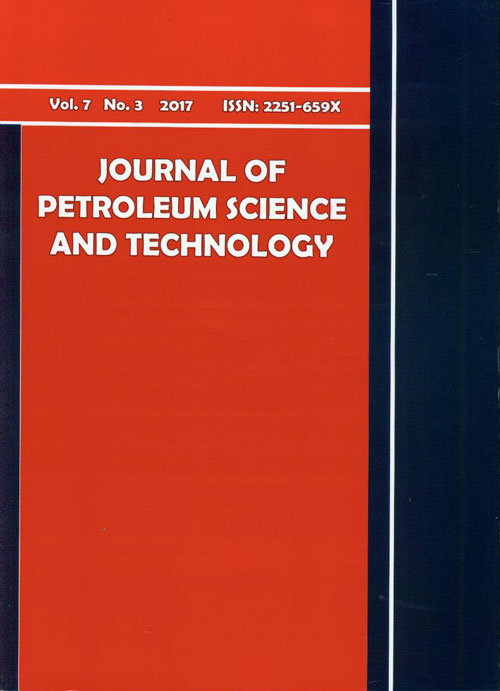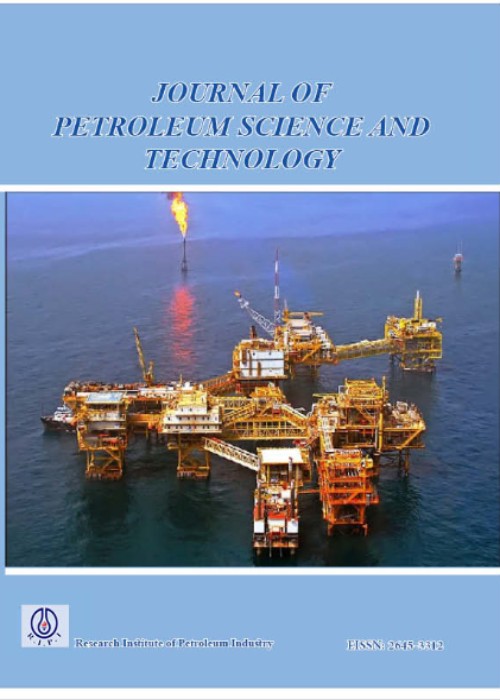فهرست مطالب

Journal of Petroleum Science and Technology
Volume:7 Issue: 3, Autumn 2017
- 142 صفحه،
- تاریخ انتشار: 1396/08/02
- تعداد عناوین: 8
-
-
Pages 3-14Microscopic oil displacement of water flooding and sweep efficiency of continuous gas injection could be improved by water alternating gas (WAG) injection. The WAG injection process aims to squeeze more oil out of the reservoirs; in this method, water and gas are alternatively injected into the reservoir. Also, availability of hydrocarbon or CO2 gases in the field makes it attractive for gas-based enhanced oil recovery (EOR) methods such as water alternating gas (WAG) injection. Conducting some simulations are required to optimize EOR methods for investigating the effect of parameters affecting WAG injection. Reducing and controlling the mobility ratio, creating stable front, and preventing early fingering of gas are the advantages of water alternating gas injection, which have promoted extensive applications throughout the world. Critical parameters, including WAG ratio, injection rates, gas composition variation, cycle times and some others which affect the WAG injection as an enhanced oil recovery method are studied thoroughly in this paper. Because of higher mobility of water relative to gas, injected water has more efficiency, but the excess use of water will cause early breakthrough. This study suggests that injecting proper volume at suitable times with different rates during injection time provides a 10 -15 % improvement in the recovery factor for one pore volume which is injected by using commercial reservoir simulator ECLIPSE 300. The best rate variation during a cycle time of WAG injection and choosing of first injection phase are discussed in this paper.Keywords: Water Alternating Gas (WAG), Simulation, Mobility Ratio, WAG Ratio, Enhanced Oil Recovery (EOR), Permeability
-
Pages 15-32To avoid the secondary pollution that inorganic corrosion inhibitor may cause in circulating cooling water, the bio-corrosion inhibition effect of lysozyme, catalase, lipase, and laccase, as the biologic inhibitors without the above problem, and the increased bio-corrosion inhibition effect of Ca and Mg are studied. An enzyme with corrosion properties was selected by rotary coupon test. The inhibition rate test and the inhibition rate of ultraviolet test of lysozyme as well as lipases SEM analysis and elemental analysis were used to explore its inhibition mechanism. Aiming to decrease enzymes usage cost, the rotary coupon test was performed to study the effect of different ion mass concentrations on enzyme activity; its inhibition effect was first analyzed, and the complex formulation of enzyme with ion and polyaspartate was then investigated. The experiment showed that among all single enzymatic reagents, lysozyme and lipase had the best corrosion inhibition effect, and when Ca mass concentration range was 107.75-182.57 mg/L, enzyme activity, microbial resistance, and corrosion inhibition properties were improved; a sample compound showed the best corrosion inhibition effect when 10 mg/L, 50 mg/L, and 50 mg/L of lysozyme, lipase, and poly-aspartic acid respectively were used. When the corrosion speed was controlled at 0.005 mm/a, the inhibition efficiency was above 95%.Keywords: Enzyme, Circulating Cooling Water, Corrosion
-
Pages 33-46Reservoir formations exhibit a wide range of heterogeneity from micro to macro scales. A simulation that involves all of these data is highly time consuming or almost impossible; hence, a new method is needed to meet the computational cost. Moreover, the deformations of the reservoir are important not only to protect the uppermost equipment but also to simulate fluid pattern and petroleum production strategy. In this regard, multiscale multiphysic mixed geomechanical model (M3GM) is recently developed. However, applications of petroleum reservoirs through gas or water injection in the depleted reservoir are in concern. In the present paper, a multiscale finite volume framework and a finite element method are employed to simulate fluid flow and rock deformation respectively. The interactions of solid and fluid phases are instated through the M3GM framework. Then, its application in the petroleum reservoir through injection process is validated. The numerical results are compared with the fine scale simulations and reasonable agreement with high computational efficiency is obtained.Keywords: Multiscale, Petroleum Reservoir, Computational Efficiency, Interaction, Injection
-
Pages 47-66The Oligo-miocene Asmari formation is one of the most important hydrocarbon reservoirs in the southwest of Iran. In order to evaluate reservoir quality and the factors controlling reservoir properties, detailed geological and petrophysical studies were carried out on 242 m of core samples from Asmari reservoir. This study is a part of a larger project that examines depositional history and reservoir properties of the Asmari formation in the Cheshmeh-Khush field. Macroscopic and microscopic studies resulted in the determination of 5 shallow marine carbonate facies (from proximal open marine to tidal setting) and also 5 silisiclastic lithofacies (including channel, barrier, tidal, and shoreface sandstones). Based on the integrated results from sedimentological and paleontological studies, Sr isotopes dating, gamma-ray logs, and seismic data analysis, 5 depositional sequences with constituent system tracts were distinguished.
In this research, the reservoir characterization of the Asmari reservoir were carried out through the integration of geological and petrophysical properties. In the first step, 21 hydraulic flow units (HFU or FU) were identified and then, to achieve better lateral correlation and modeling, HFUs were merged to 17.
The results from this study showed different behaviors of the silisiclastic and carbonate facies next to the fluid flow. The findings of this study indicate that the lateral and vertical distribution of channel-filled sandstones (such as units 2 and 8) are strongly controlled by the geometry of depositional facies. Thus, the correlation and modeling of flow units, solely on the basis of lithology and thickness, and regardless of facies and its geometry, will cause different facies (such as coastal and channel-filled sandstones) with different geometry, and reservoir quality are placed incorrectly in a single flow unit.
In the carbonate parts of Asmari formation, the effect of diagenetic processes on reservoir quality is much higher than the facies. Hence, the LST limestones of unit 17, as a result of calcite cementation, were changed to a thick, distinct, correlatable, and barrier unit. On the other hand, dolomitic intervals that have not been affected by anhydrite cementation have formed porous and permeable carbonate reservoir units (such as units 18 and 21).Keywords: Asmari Formation, Reservoir Quality, Flow Units, Sequence Stratigraphy, Facies Modeling -
Pages 67-83High pressure mercury, nitrogen adsorption, nano-CT, and scanning electron microscope with energy spectrum analysis were conducted on core shale samples for studying the characteristics of Taiyuan formation in the eastern uplift of Liaohe depression. The research results show that the shale gas reservoir pores are mainly open pores such as the wedge-shape pores and parallel-plate pores. By a genetic type, pores mainly include organic pore, pyrite crystal particle pore, illite intragranular pore, illite-smectite mixed layer intragranular pore, and feldspar dissolved pore. The micropore and mesopore play an important role in shale gas reservoir, and their surface area and pore volume are 9.56 m2/g, 0.0414 mL/g, 97.3%, and 68.8% respectively. The pores diameter presents a bimodal distribution with two main peaks at 43 nm and 6.35 μm. Based on the nano-CT, the porosity is 4.36% and the permeability is 204 nD. The brittle minerals played a supportive and protective role for the pores and controlled their spatial distribution.Keywords: Liaohe, Marine-continental Transitional Facies, Taiyuan Formation, Shale, Pore
-
Pages 84-99The classification of well-log responses into separate flow units for generating local permeability models is often used to predict the spatial distribution of permeability in heterogeneous reservoirs. The present research can be divided into two parts; first, the nuclear magnetic resonance (NMR) log parameters are employed for developing a relationship between relaxation time and reservoir porosity as well as introducing the concept of relaxation group. This concept is then used for the definition of electrofacies in the studied reservoir. A graph-based clustering method, known as multi resolution graph-based clustering (MRGC), was employed to classify and obtain the optimum number of electrofacies. The results show that the samples with similar NMR relaxation characteristics were classified as similar groups. In the second part of the study, the capabilities of nonlinear support vector machine as an intelligent model is employed to predict the electrofacies and permeability distribution in the entire interval of the reservoir, where the NMR log parameters are unavailable. SVM prediction results were compared with laboratory core measurements, and permeability was calculated from stoneley wave analysis to verify the performance of the model. The predicted results are in good agreement with the measured parameters, which proves that SVM is a reliable tool for the identification of electrofacies through the conventional well log data.Keywords: Flow Zone Index, Electrofacies, Support Vector Machine, Nuclear Magnetic Resonance, Conventional Petrophysical Data
-
Pages 100-116The middle Sarvak formation (Cenomanian) is one of the stratigraphic units of the Bangestan group in the south of Iran. This formation is stratigraphically equivalent to the Ahmadi member of Kuwait and Iraq. There is geochemical evidence that indicates this unit has a high level of organic richness and can be a possible source rock in various locations. This study focuses on the organic geochemistry of the middle Sarvak formation in the Persian Gulf region. Rock Eval pyrolysis, organic petrography, and kerogen elemental analyses were used in order to evaluate the thermal maturity and determine the kerogen type of the middle Sarvak formation. The results of this study show that middle Sarvak formation has entered the oil window in eastern and western parts of the Persian Gulf, but it is immature in the central parts. This regional pattern of organic maturation is probably a consequence of the regional uplift in the Qatar-Fars arch area. The higher maturities in the eastern and western parts are, on the other hand, attributed to its greater depth of burial. The results of the screening analyses by the Rock-Eval pyrolysis in parallel with the results of maceral and elemental analyses show that the kerogen type in the middle Sarvak formation is mainly a mixture of Types II and III.Keywords: Middle Sarvak Formation, Rock Eval Pyrolysis, Organic Petrography, the Persian Gulf
-
Pages 117-134The study of the carbonate cements in the Permian-Triassic Dalan-Kangan formations resulted in the identification of five stages of calcite and dolomite cementation, which completely or partially occluded pores. Cement types appear to be early isopachous calcite (i; C1-non-luminescence), equant (ii; C2-dull CL), fairly coarse secondary dolomite rhombs (iii; C3-zoning red CL), coarse sparry calcite (iv; C4-dull CL), and meteoric equant calcite (v; C5-bright orange CL & vi; C6-bright yellow CL). Fluid inclusion analyses invoked three distinct groups of fluids. Group 1 is reflected by fluids with equant calcite (C2) composition, characterized by Th values (126 °C) and salinity of 16 wt.% (NaCl equivalent), and they are interpreted as burial pore-waters. Group 2, which is represented by fluids associated to shallow burial dolomite cementation (C3), has Th values about (127 °C) and salinity of 17 wt.% (NaCl equivalent). The last group, i.e. coarse sparry calcite (C4), is occurred along fractures and vugs and characterized by high Th values (169 °C) and salinity of 17.5 wt.% (NaCl equivalent) which shows that fluids with a higher temperature migrated from deeper parts during deep burial. The hydrocarbon inclusions with yellow fluorescence can be observed in coarse calcite filling fractures in Dalan formation which shows that they are secondary, and hydrocarbon migration predates the precipitation of fracture filling cements.Keywords: Diagenesis, Fluid Inclusion, Kangan, Dalan


